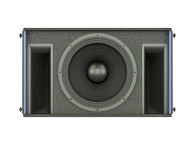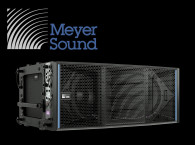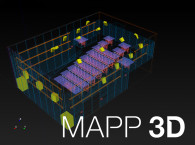 Boasting extraordinary power-to-weight ratio and ultra-low distortion, Leopard and the 900-LFC join Meyer Sound’s flagship LEO family as its smallest and most versatile members. Boasting tremendous power-to-size ratio with ultra-low distortion, the patent-pending Leopard line array loudspeaker and the 900-LFC low-frequency control element offer an unprecedented level of clarity, power, precision, and ease of use.
Boasting extraordinary power-to-weight ratio and ultra-low distortion, Leopard and the 900-LFC join Meyer Sound’s flagship LEO family as its smallest and most versatile members. Boasting tremendous power-to-size ratio with ultra-low distortion, the patent-pending Leopard line array loudspeaker and the 900-LFC low-frequency control element offer an unprecedented level of clarity, power, precision, and ease of use.With state-of the-art design, groundbreaking engineering, and premium quality components, Leopard AND 900-LFC are designed to create an exceptional listening experience across a wide variety of applications from rental to install and rock ‘n’ roll to classical.
“I’ve always followed my own path in this business, never satisfied until something is the best it can be,” said John Meyer, Founder and CEO of Meyer Sound. “With the LEO Family we set out to reduce distortion to the theoretical limits and both LEOPARD and 900-LFC bring us even closer to the goal of the ultimate linear loudspeaker system. Quality components, amazing technology, incredible convenience, and elegant design are critically important, but it’s really the results that matter. To borrow an analogy from the auto industry, sometimes you have to just get behind the wheel and take it for spin. With Leopard and 900 LFC, you just have to listen. Once you hear it, you’ll want it.”
The new line array system features greater phase coherence and seamless, uniform coverage achieving 10 times less distortion with significantly more power than similar products in the same compact class. The Leopard line array and matching low-frequency elements use newly designed and highly efficient class-D amplifiers that virtually eliminate distortion while consuming less power and generating less heat.
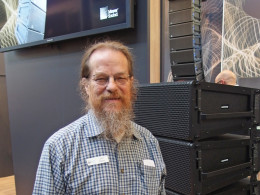
The Leopard system was designed to both anchor a main system in a medium-sized venue or integrate seamlessly with the Lyon line array in down- and out-fill systems. Six Leopard and two 900-LFC loudspeakers can be flown using a ½ ton motor. A complete system solution also includes MAPP XT for acoustic prediction, Compass RMS for real-time system performance monitoring, the Galileo Callisto loudspeaker management system, and the new MDM-5000 distribution module for routing AC power, audio, and RMS signals.
All products are crafted by hand and rigorously tested for quality control onsite at the Meyer Sound headquarters in Berkeley, Califonia. The Leopard and 900-LFC will begin shipping in summer 2015.
Meyer Sound MAPP XT
Meyer Sound also announced MAPP XT, the first audio system design tool that allows users to design systems with truly useful loudspeaker headroom information. In addition to an updated user interface and new features that streamline workflow, MAPP XT shows the maximum levels to which Meyer Sound loudspeaker systems can be driven while maintaining linear performance, empowering customers to specify high-performance systems that reflect the needs of their shows.
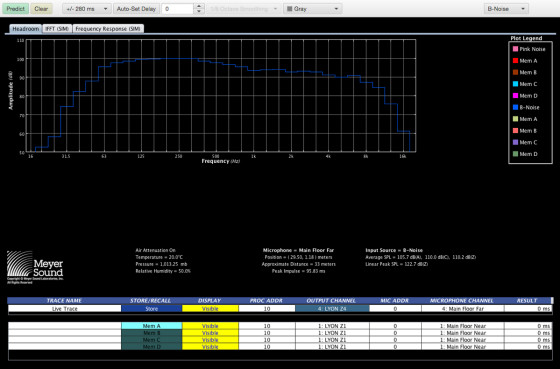
“It’s always been our vision to produce highly accurate sound systems that amplify the source material faithfully at all output levels. MAPP XT provides a whole new way of looking at headroom by showing the full available power capacity of a system while maintaining linearity and regardless of equalization in digital processing,” says John Meyer.
Headroom information is the most significant new feature in MAPP XT, and can be viewed from the perspectives of two different input signals. They include the traditional broadband pink noise and B-Noise, a new input signal designed to better represent the most common input spectrum in real-world applications.
“As a test signal, pink noise has been an excellent but conservative way for showing system behavior and it rarely reflects actual show content,” continues Meyer. “Introducing B-Noise data and headroom information in MAPP XT is an important step to provide measurements that are independently verifiable and represent the linear performance of Meyer Sound systems in real-world applications so customers get the best results every time.”
The Auto-Splay feature in MAPP XT allows users to select the starting and finishing angles and automatically calculates the optimum splay angles between cabinets. Factor of Safety shows whether a proposed LEO, Lyon or Leopard array is within limits for the given configuration and angle to help users meet safety standards including 5:1, 7:1, and BGV-C1.
The Gradient Subwoofer Array Tool quickly and accurately configures cardioid low-frequency arrays with the 500-HP, 900-LFC, and 1100-LFC models, saving valuable time for system designers. Trace Store and Recall provide fast comparisons of different configuration options, while Relative Phase Response data allows users to combine different elements more easily. A PDF Export feature promotes easier sharing of system designs among project team members.
http://meyersound.com/product/leopard/
http://meyersound.com/product/900-lfc/
http://meyersound.com/product/mapp-xt/



